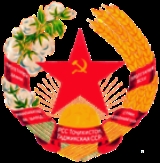
Coat of arms of the Tajik SSR
Encyclopedia
The coat of arms of the Tajik Soviet Socialist Republic was adopted on March 1, 1937 by the government of the Tajik Soviet Socialist Republic. The coat of arms is based on the coat of arms of the Soviet Union
. It shows symbols of agriculture
(cotton
and wheat
). The red star
is prominently featured with a small hammer and sickle
within it. The rising sun
stands for the future of the Tajik nation, and the star as well as the hammer and sickle for the victory of communism
and the "world-wide socialist community of states".
The banner bears the Soviet Union state motto ("Workers of the world, unite!
") in both the Tajik
and Russian language
s. In Tajik, it is "Пролетарҳои ҳамаи мамлакатҳо, як шавед!" (transliterated: "Proletarhoi hamai mamlakatho, jak şaved!").
The name of the republic is also shown in both Tajik and Russian.
The emblem was changed in 1992 to the present Tajikistan coat of arms
, which uses a design similar to that of the Soviet one.
Soviet Union
The Soviet Union , officially the Union of Soviet Socialist Republics , was a constitutionally socialist state that existed in Eurasia between 1922 and 1991....
. It shows symbols of agriculture
Agriculture
Agriculture is the cultivation of animals, plants, fungi and other life forms for food, fiber, and other products used to sustain life. Agriculture was the key implement in the rise of sedentary human civilization, whereby farming of domesticated species created food surpluses that nurtured the...
(cotton
Cotton
Cotton is a soft, fluffy staple fiber that grows in a boll, or protective capsule, around the seeds of cotton plants of the genus Gossypium. The fiber is almost pure cellulose. The botanical purpose of cotton fiber is to aid in seed dispersal....
and wheat
Wheat
Wheat is a cereal grain, originally from the Levant region of the Near East, but now cultivated worldwide. In 2007 world production of wheat was 607 million tons, making it the third most-produced cereal after maize and rice...
). The red star
Red star
A red star, five-pointed and filled, is an important ideological and religious symbol which has been used for various purposes, such as: state emblems, flags, monuments, ornaments, and logos.- Symbol of communism :...
is prominently featured with a small hammer and sickle
Hammer and sickle
The hammer and sickle is a part of communist symbolism and its usage indicates an association with Communism, a Communist party, or a Communist state. It features a hammer and a sickle overlapping each other. The two tools are symbols of the industrial proletariat and the peasantry; placing them...
within it. The rising sun
Sun
The Sun is the star at the center of the Solar System. It is almost perfectly spherical and consists of hot plasma interwoven with magnetic fields...
stands for the future of the Tajik nation, and the star as well as the hammer and sickle for the victory of communism
Communism
Communism is a social, political and economic ideology that aims at the establishment of a classless, moneyless, revolutionary and stateless socialist society structured upon common ownership of the means of production...
and the "world-wide socialist community of states".
The banner bears the Soviet Union state motto ("Workers of the world, unite!
Workers of the world, unite!
The political slogan Workers of the world, unite! is one of the most famous rallying cries of communism, found in The Communist Manifesto , by Karl Marx and Friedrich Engels...
") in both the Tajik
Tajik language
Tajik, Tajik Persian, or Tajiki, is a variety of modern Persian spoken in Central Asia. Historically Tajiks called their language zabani farsī , meaning Persian language in English; the term zabani tajikī, or Tajik language, was introduced in the 20th century by the Soviets...
and Russian language
Russian language
Russian is a Slavic language used primarily in Russia, Belarus, Uzbekistan, Kazakhstan, Tajikistan and Kyrgyzstan. It is an unofficial but widely spoken language in Ukraine, Moldova, Latvia, Turkmenistan and Estonia and, to a lesser extent, the other countries that were once constituent republics...
s. In Tajik, it is "Пролетарҳои ҳамаи мамлакатҳо, як шавед!" (transliterated: "Proletarhoi hamai mamlakatho, jak şaved!").
The name of the republic is also shown in both Tajik and Russian.
The emblem was changed in 1992 to the present Tajikistan coat of arms
Coat of arms of Tajikistan
The State Emblem of Tajikistan is a modified version of the original coat of arms of the Tajik SSR that was in use until the dissolution of the Soviet Union in 1991...
, which uses a design similar to that of the Soviet one.

